Types of Joints
In humans and other vertebrates, a framework of bones is formed called the skeletal system. About 206 bones in the adult human body give structural shape, provide protection for inner organs, and help in locomotion (body movements). Bones in different parts of the body are connected in such a way that they can easily move accordingly. To facilitate proper movements, different joints exist in the human body.
In this article, we are discussing the major types of joints which are present in the human body. Before discussing the various joints types, let us first discuss the definition of a joint and its major components:
What is a Joint?
In particular, a joint refers to the point where two or more objects connect. In context to the human body or the skeleton system, a joint refers to a point where two bones intersect. In other words, a joint is characterized by the connection that occurs between the bones in the skeletal system. The joint is also referred to as an articulation/ articular surface.
By definition, "a joint refers to a point where two bones connect to establish a framework that permits movements."
The joints are essential organs for almost all body movements that involve bones. Because of the joints, we move our body parts. For example, bending our knees or elbows, rotating our shoulders, swiveling our neck, etc. In particular, the muscles' force is utilized to carry out movements through different types of joints. However, the degree and ease of movement at various joints depend on lots of factors.
Some common areas where joints occur in the human body are displayed in the following image:
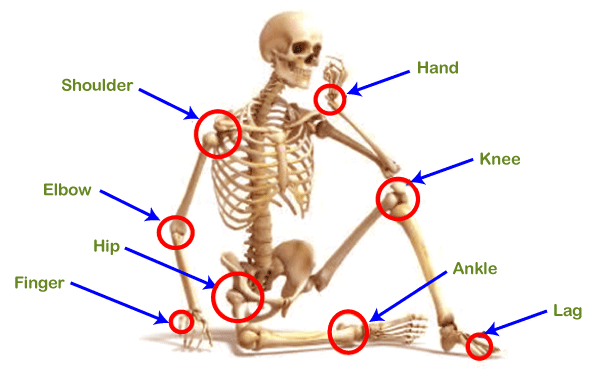
Bones are typically connected on joints using some tissue and other components to make them functional.
Components of Joints
Joints typically consist of the following major parts:
- Cartilage: Cartilage is defined as the tissue covering the bone's surface at joints. This mainly helps in reducing the friction of movement within the joints.
- Synovial Membrane: Synovial membrane is a type of tissue that typically helps to line the joints and seal them into a joint capsule. Furthermore, it secretes a clear, sticky fluid (synovial fluid) around the joints to lubricate them.
- Ligaments: Ligaments are defined as rigid elastic bands of connective tissue surrounding the joints to add additional support and limit the joints' movements. In particular, ligaments help to connect the bones.
- Tendons: Tendons are another strong connective tissue that mainly helps to connect muscles with bones. They are present on each side of joints attaching muscles to control the joints' movements.
- Bursas: Bursas are typical fluid-filled sacs commonly found between bones, ligaments, or other nearby structures. The primary function of the bursas is to help reduce the friction of joints.
- Synovial Fluid: The synovial fluid is a clear, viscous fluid secreted by the synovial membrane.
- Meniscus: The meniscus is a distinctly curved part of the cartilage found in the knees and other joints.
Types of Joints
Different types of joints mainly define degrees and types of movement on the corresponding part of the body where they are used. They can be easily classified based on the following two types:
- Functional Classification of Joints
- Structural Classification of Joints
Let us discuss each in detail:
Classification of Joints based on the Functionality
The joints' functional classification is primarily based on the type of movements or the type and degree of permission. Depending on the type and degree of movement allowed, the joints are divided into three types such as immovable, slightly movable, and freely movable joints.
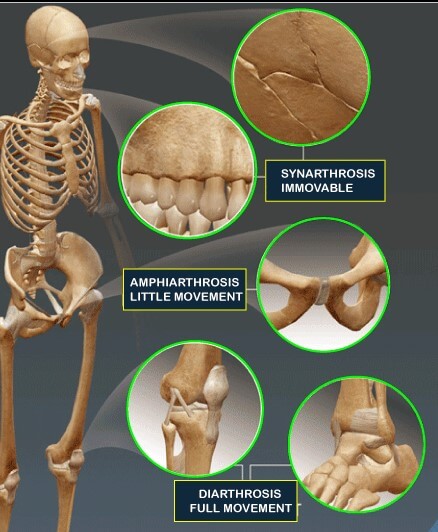
Each type is mentioned below with examples:
Immovable Joints
Immovable joints refer to all such joints that do not allow any movement. These joints are also called Synarthrosis. The sutures found in the skull and gomphosis that connect teeth to the skull are the common examples of immovable joints.
Slightly Movable Joints
Slightly movable joints typically allow very little movement at the joints. These joints are also called Amphiarthrosis. The intervertebral disks found in the spine and the public symphysis found in hips are common examples of the slightly movable joints.
Freely Movable Joints
Another type of joint is the freely movable joints, also called diarthrosis joints. These are joints that allow the highest range of movements than other types of joints. They are the most flexible and allow our body-parts to move in different directions freely. Examples of freely movable joints include the wrist, shoulder, knee, elbow, etc.
Classification of Joints based on the Structure
Based on joints' structural classification, there are mainly three types: fibrous, cartilaginous, and synovial joints. Let us discuss each in detail:
Fibrous Joints
Fibrous joints are the simplest type of joints and have very little to no mobility. This means that joints are present in those body areas where bones have no flexibility or require no motion. In fibrous joints, the adjacent bones are connected using the fibrous connective tissue. Since there is no space left between the bones, most fibrous joints do not permit any movement. In another way, the movements are minor and so are almost negligible. These immovable or fixed joints are interlocked with irregular edges in a distinct style. In particular, fibrous joints are formed mainly to create a structure for the human body's specific part. These joints are usually found in three distinct parts of the body, depending on their types.
Fibrous joints are further sub-divided into the following three types:
- Sutures: Sutures can be found in the skull by three years of age. They are soft areas/ regions that typically fuse between cranial bones and often called cranial sutures. In simple words, sutures are joints that usually help in holding the skull bones tightly by using the short connective tissue fibers (called sutural ligaments). Besides, the adjacent bones ossify over time, and therefore, suture lines are usually obliterated.
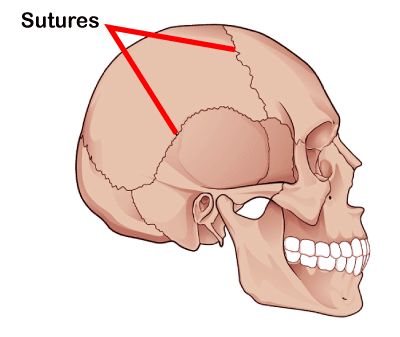
- Syndesmoses: The second type of fibrous joints is termed syndesmoses. Syndesmoses represent joints where bones are interconnected using the band of connective tissue (called interosseous ligaments). This eventually allows very little movement to connective tissue fibers, and the amount of movement mainly depends on the length of individual fibers.
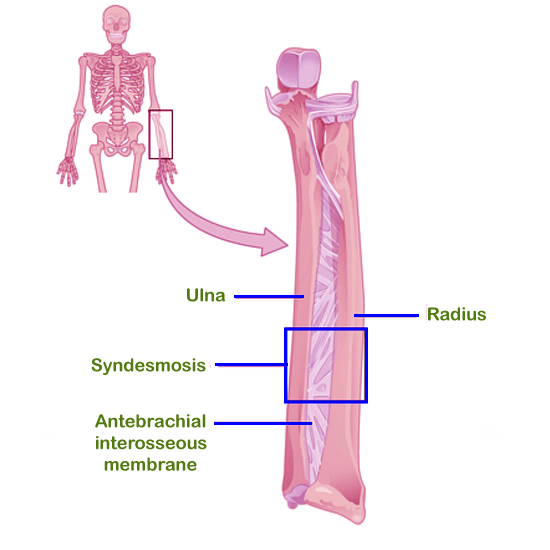
- Gomphosis: The third and final fibrous joints are gomphosis and are found in the mouth. Gomphoses (plural of gomphosis) refer to the points in which the teeth' pegged end is joined with the dental alveoli. In simple words, gomphosis is found between teeth and their sockets. The tooth is bound to its sockets using a connective tissue named periodontal ligament.
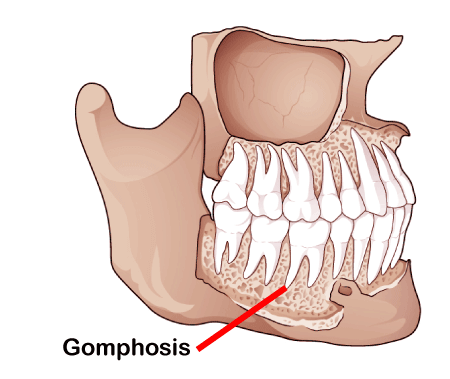
Cartilaginous Joints
Cartilaginous joints are identified by the joints where bones are connected using the cartilage. These joints typically allow movements more than the fibrous joints but less than the synovial joints. In other words, these joints are partially movable. Cartilaginous joints permit a range of movements lying between movements allowed through fibrous and synovial joints.
Cartilaginous joints are further sub-divided into the following two types:
- Synchondrosis joints: Synchondrosis joints are often termed primary cartilaginous joints. In these joints, the hyaline cartilage usually meets with bones. Syynchondrosis joints are found in the epiphyseal (growth) plates of growing bones in young children. The epiphyseal plates found at each end of long bones mainly help to grow bones in children. Besides, these cartilaginous joints are temporary and typically last until the end of children's puberty.
- Symphysis Joints: Symphysis joints or symphyses are often called the secondary cartilaginous joints. These joints are mainly found along the midline of the body and are permanent. Generally, symphysis joints involve adjacent bone surfaces lined with hyaline cartilage and connected by fibrous tissue. These joints can have some degree of mobility, allowing very little movement. Sometimes, there can also be joint cavities, but they will never be synovial. The common examples of symphysis joints include the intervertebral joints, pubic symphysis, and the manubriosternal angle of Louis.
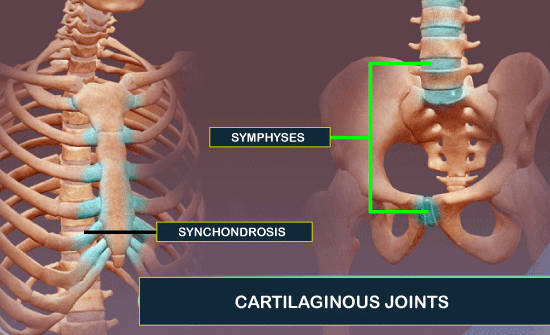
Synovial Joints
Synovial joints are the most common types of joints in the human body, and they are joints helping us perform movements. These types of joints typically have space between the adjacent bones. This space is known as the synovial cavity, and it consists of synovial fluid. The synovial fluid mainly takes part in lubricating the joints to reduce the friction between the bones. As a result, synovial joints provide a range of movements such as walking, dancing, typing, and many more.
Apart from this, the ends of bones are covered with a protected layer of articular cartilage, and an articular capsule further protects the whole joint. The articular capsule consists of connective tissue and permits movements in proper directions, blocking the wrong direction movements. Furthermore, it also provides ligaments to hold the bones tightly. Major examples of synovial joints are shoulders, elbows, and knees.
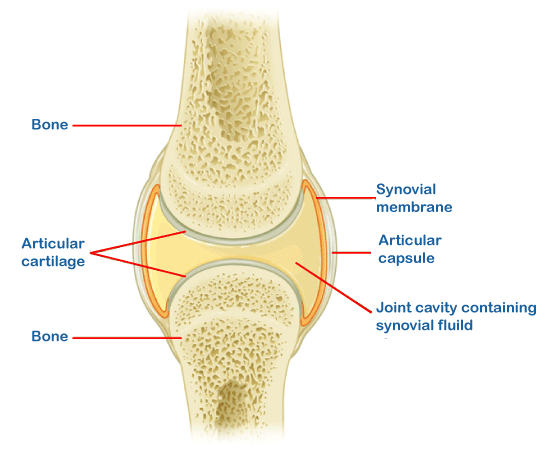
Synovial joints are further sub-divided into the following six types:
- Ball and Socket Joints: In these types of joints, the rounded head of one bone is hooked up into the cup of another bone. Ball and socket joints typically allow movements in almost all directions, including the forward, backward, sideways, and rotary movements. The most common examples of ball and socket joints are the shoulder joints and hip joints.
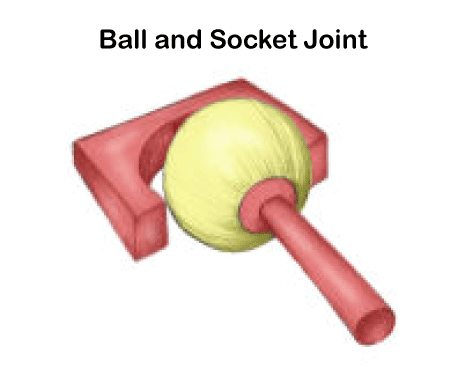
- Hinge Joints: Hinge joints are similar to the door, allowing us to open and close in one direction in a single plane. More specifically, hinge joints allow movements in only forward and backward directions (bending and straightening movements across one plane). The common examples of hinge joints are fingers, elbows, knee, ankle, toes, etc.
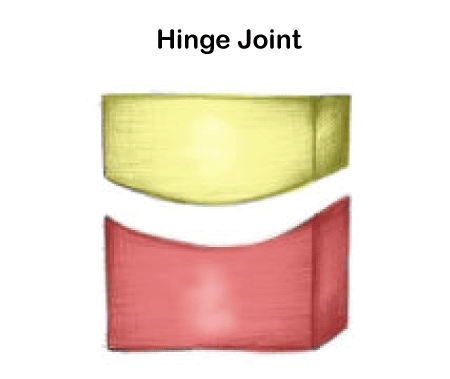
- Condyloid Joints: Condyloid joints refer to all those joints that contain two axes to move, but there is no support for the rotation. These types of joints mainly allow side-by-side movements and up-down movements. Condyloid joints are also called condylar, or ellipsoid joints. These joints are found in the fingers' base (primarily for the index finger), wrist carpals, wrist joints, and elbows.
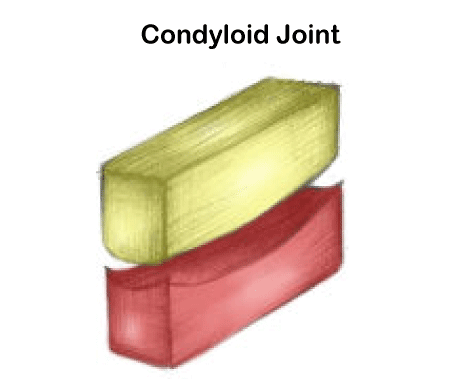
- Pivot Joints: Pivot joints are known for providing limited rotary movements. The full rotation is impossible in these joints because one bone is typically tapped into the other bone so that the first one can only swivel in a ring area formed by a second bone. These joints usually permit sideways and back-forth movements. Pivot joints are also called pivotal joints, rotary joints, and trochoid joints. The pivot joint can be found at the top of the neck between the atlas and axis bones (between the first and second vertebrae in your neck). Another example includes the joints found between ulna and radius bones that mainly help in rotating the forearm.
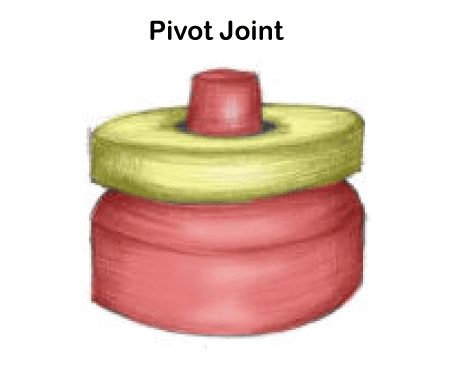
- Gliding Joints: Gliding joints are joints that only allow two or more flat or round bones to move freely simultaneously. The bones do not rub or crush on one another. Gliding joints are also called the plane joints and planar joints. Gliding joints are the common type of synovial joints. These joints are found in those parts of the body where the two different bones meet and slip over one another in any direction. Major examples of gliding joints include the ankle joints to the lower legs and intercarpal joints in the hands.
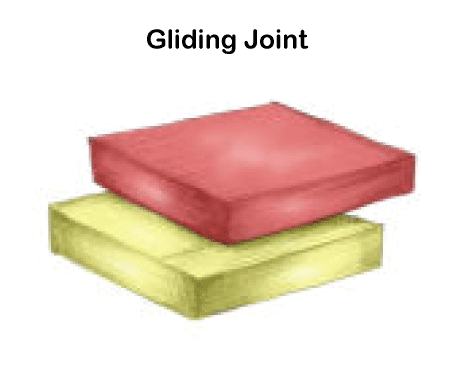
- Saddle Joints: Saddle joints do not permit rotation. They are formed in such a way that they only allow the movements on two planes. Saddle joints are biaxial and typically allow flexion/ extension, adduction/ abduction, or circumduction. The thumb is the only bone that contains saddle joints between the first metacarpal and trapezium. We can move a thumb in back-forth and side-ways directions due to saddle joints, crossing it over the palm.
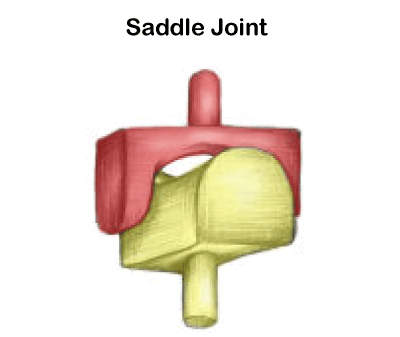
Ranges of Motion at Joints
Based on the axes, there are mainly four different types of ranges of motion at joints. Based on the location of joints, they can be uniaxial, biaxial, polyaxial, or gliding.
- Uniaxial: The joints which allow movements in a single axis come to the category of uniaxial. They typically enable moving bones back and forth along the axis.
- Biaxial: The joints permitting movement about two distinct axes come to the category of biaxial.
- Polyaxial: The joints that usually allow movements along all three axes come to the category of polyaxial.
- Gliding Movements: Gliding movement refers to the types of joints that only allow bones to slide over one another. This mainly includes the flat bones.
|




 For Videos Join Our Youtube Channel: Join Now
For Videos Join Our Youtube Channel: Join Now


















